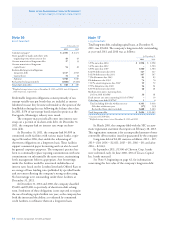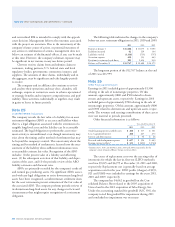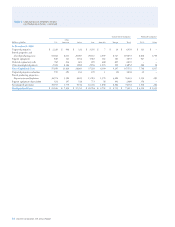Chevron 2011 Annual Report Download - page 66
Download and view the complete annual report
Please find page 66 of the 2011 Chevron annual report below. You can navigate through the pages in the report by either clicking on the pages listed below, or by using the keyword search tool below to find specific information within the annual report.
64 Chevron Corporation 2011 Annual Report
Notes to the Consolidated Financial Statements
Millions of dollars, except per-share amounts
the company made payments of $74 associated with these lia-
bilities. e majority of the payments were in Downstream.
e balance at December 31, 2011, was classied as a current
liability on the Consolidated Balance Sheet.
Amounts Before Tax
Balance at January 1, 2011 $ 138
Adjustments (28)
Payments (74)
Balance at December 31, 2011 $ 36
Note 24
Other Contingencies and Commitments
Income Taxes e company calculates its income tax expense
and liabilities quarterly. ese liabilities generally are subject
to audit and are not nalized with the individual taxing
authorities until several years after the end of the annual
period for which income taxes have been calculated. Refer to
Note 15, beginning on page 51, for a discussion of the
periodsfor which tax returns have been audited for the com-
pany’s major tax jurisdictions and a discussion for all tax
jurisdictions of the dierences between the amount of tax
benets recognized in the nancial statements and the
amount taken or expected to be taken in a tax return. e
company does not expect settlement of income tax liabilities
associated with uncertain tax positions to have a material
eect on its results of operations, consolidated nancial
position or liquidity.
Guarantees e company’s guarantee of approximately $600
is associated with certain payments under a terminal use
agreement entered into by a company aliate. e termi-
nal commenced operations in third quarter 2011. Over the
approximate 16-year term of the guarantee, the maximum
guarantee amount will be reduced over time as certain fees
are paid by the aliate. ere are numerous cross-indemnity
agreements with the aliate and the other partners to permit
recovery of amounts paid under the guarantee. Chevron has
recorded no liability for its obligation under this guarantee.
Indemnications e company provided certain indemnities
of contingent liabilities of Equilon and Motiva to Shell and
Saudi Rening, Inc., in connection with the February 2002
sale of the company’s interests in those investments. rough
the end of 2011, the company paid $48 under these indem-
nities and continues to be obligated up to $250 for possible
additional indemnication payments in the future.
e company has also provided indemnities relating to
contingent environmental liabilities of assets originally con-
tributed by Texaco to the Equilon and Motiva joint ventures
and environmental conditions that existed prior to the for-
mation of Equilon and Motiva, or that occurred during the
period of Texaco’s ownership interest in the joint ventures.
In general, the environmental conditions or events that are
subject to these indemnities must have arisen prior to Decem-
ber 2001. Claims had to be asserted by February 2009 for
Equilon indemnities and must be asserted no later than Feb-
ruary 2012 for Motiva indemnities. In February 2012, Motiva
Enterprises LLC delivered a letter to the company purporting
to preserve unmatured claims for certain Motiva indemnities.
e letter itself provides no estimate of the ultimate claim
amount. Management does not believe this letter or any other
information provides a basis to estimate the amount, if any, of
a range of loss or potential range of loss with respect to either
the Equilon or the Motiva indemnities. Under the terms of
these indemnities, there is no maximum limit on the amount
of potential future payments. e company posts no assets as
collateral and has made no payments under the indemnities.
e amounts payable for the indemnities described in
the preceding paragraph are to be net of amounts recov-
ered from insurance carriers and others and net of liabilities
recorded by Equilon or Motiva prior to September 30, 2001,
for any applicable incident.
In the acquisition of Unocal, the company assumed
certain indemnities relating to contingent environmental
liabil ities associated with assets that were sold in 1997. e
acquirer of those assets shared in certain environmental
remediation costs up to a maximum obligation of $200, which
had been reached at December 31, 2009. Under the indemni-
cation agreement, after reaching the $200 obligation, Chevron
is solely responsible until April 2022, when the indemnica-
tion expires. e environmental conditions or events that are
subject to these indemnities must have arisen prior to the sale
of the assets in 1997.
Although the company has provided for known obliga-
tions under this indemnity that are probable and reasonably
estimable, the amount of additional future costs may be
material to results of operations in the period in which they
are recognized. e company does not expect these costs will
have a material eect on its consolidated nancial position
orliquidity.
Long-Term Unconditional Purchase Obligations and Commit-
ments, Including roughput and Take-or-Pay Agreements e
company and its subsidiaries have certain other contingent
liabilities with respect to long-term unconditional purchase
obligations and commitments, including throughput and
take-or-pay agreements, some of which relate to suppliers’
nancing arrangements. e agreements typically provide
goods and services, such as pipe line and storage capacity, drill-
ing rigs, utilities, and petroleum products, to be used or sold
in the ordinary course of the company’s business. e aggre-
gate approximate amounts of required payments under these
Note 23 Restructuring and Reorganization – Continued
























